Today, we take a deeper dive into what we discussed with Sacramento County Master Gardener Gail Pothour in Episode 391 of the Garden Basics with Farmer Fred podcast: “A Masterclass in Melons”. If you will be growing melons this year, be they canteloupes, muskmelons, honeydews, or watermelons, give a listen to that podcast episode for a lot of great tips.

As a bit of a teaser, in the podcast segment in today’s newsletter, Gail talks about how to start a melon from seed. It’s easy, and they’ll germinate in less than a week and be ready to go in the ground in about three weeks. So, there’s plenty of time this spring to choose the seeds and get them started for a 2025 harvest. Gail goes into those details. Plus, in the podcast segment at the top of this newsletter, Gail offers good advice on how to choose young melon plants from the local nursery. Her main point: choose them when there are only two sets of true leaves on the plant. Stay away from those melon plants that have overgrown their small nursery container, because cramped roots can effect adversely its future life when transplanted into the garden. On a recent trip to the nursery, I noticed a lot of sprawling melon plants, as well as ones that only had a couple of sets of true leaves, no more than a few inches high. Those are the melon plants you want to buy!
Probably the most common question backyard melon growers ask:
“How do I know when that melon is ripe?”
We talked about that with Gail Pothour, here’s the transcript of that portion of the podcast:
Farmer Fred:
So knowing when ripeness is going to happen, I imagine there's some telltale clues. Maybe there's a change in the coloration of the rind or maybe some cracking or maybe even softening of the fruit.
Gail Pothour:
True. The muskmelons are the easiest because they tell you when they're ripe because they slip off. But you can usually tell a few days ahead of time because the background color, you've got the netting and then there's a background color that's usually kind of a greenish color. That changes to tan or golden. And then you can usually smell the melon. I'll go out to my garden in the morning and I go, ooh, I've got a melon that's ripe. I can smell it. And so I start searching for it. And it could either be one that has already slipped off or it's getting close. And so, yeah, there are some signs. Usually it's a color change and an aroma. Some of them, like the honeydew that doesn't slip off, but you can push on the blossom end and it's a little bit softer and you'll maybe get a little bit of aroma from that. They also, on the honeydew, tend to start out kind of, not hairy, but they have a little bit of fuzz or something on the outside of their skin. And then as they progress, that gets softer, and then they almost have a waxy feel on the skin when it's ready to harvest. So they're not quite as obvious as the muskmelons, what we call cantaloupes. Those are what I usually grow because they're the easiest to harvest. Keep watching it because the skin will often change. There could be an aroma and that blossom then gets soft.
Farmer Fred:
So really, probably the best sign is when it really slips easily from that stem.
Gail Pothour:
Yeah, if it's a muskmelon type, the honeydew won't. The honeydew you'll have to cut off. And the Charentais, which is a true cantaloupe, and so you don't find too many of them, but I like to grow the Ha’ogen, which is a Charentais, it has the color change. It goes from green to a golden color. It doesn't have as much of an aroma, but I can push the blossom end and get a little bit of softness there. But if the true cantaloupe slips off, it's overripe. And often you'll have cracking on the blossom end, which then gets fruit flies in there and all kinds of things. But the muskmelons are the only ones that really slip off when they're ready. And that includes what we call cantaloupes. And Galia types, they're all in that same cantaloupe. or an Ananas. Those are the three that I can think of that are in the muskmelon category.
Gail Pothour:
The watermelon is a little bit different. And I've never really learned how to tell when a watermelon is ripe. I know the skin becomes dull when it's getting close to maturity. And usually there's a ground spot where it's sitting on the ground, and that will turn from white to kind of a yellowish color and then the tendril closest to the fruit darkens there's little tendrils all along the vine and the tendril that's closest to the fruit will turn dark and kind of dry up and then there's always that old thing of wrapping on it and it'll get thump thump or think things well to me they all sound alike especially depending on what time of day you're doing it You know, in the heat of the day, they all sound the same. And one of my favorite watermelons to grow, and we've grown it at the Fair Oaks Horticulture center, is Golden Gold. It already has a yellow skin, so you can't tell where its yellow ground spot is because it's already yellow. So that one, we know it starts getting some green coloration around the stem end. You kind of have to see a picture to know what you're looking for. But that's how we tell when that one's ready. But watermelons are a little more challenging. I know that there are farmers who can look out in their field and they say, oh, that watermelon's ripe. Well, I guess that's years and years of experience. I am not that confident on picking watermelons.

Farmer Fred:
[23:06] The good news is the home gardener will get that experience, too, after a few years. If they're growing the same varieties, they'll soon discover which ones are near ripe or too ripe.
Melon Varieties Worth Trying
In Ep. 391, we delve into the many varieties of melons that are worth a try because of their taste and looks. Among Gail Pothour’s favorites:
Charentais melon

The Charentais melon is a true canteloupe, explains Gail Pothour.
The Baker Creek catalog description says: “A French melon. Super sweet and very fragrant. Light gray-green skin, smooth round 2- to 3-pound fruit, bright orange flesh.”
Ha’ogen

A favorite of Gail’s and the folks at Baker Creek, who describe it as: “An excellent-tasting, early melon and our favorite for texture. Commonly thought to have originated in Israel, where its name means “anchor” but may have actually originated in Hungary. Flavorful green flesh; good yields of nearly round, 3-4 lb fruit; a beautiful melon! Very fragrant. A longtime favorite of the Baker Creek family. Ripens in 75 days.
Galia melons
Galia melons are a cross between a cantaloupe and a honeydew, according to Wikipedia:
“The Galia melon developed in Israel, is known for its netted rind, like a cantaloupe, and pale green flesh, like a honeydew. Galia melons are grown worldwide and are typically available from spring to mid-fall. According to the trade type definition, the fruits of the Galia have the following characteristics:[5] the average weight for a Galia melon is one kilogram. They have a rounded shape, a dense netting of rough lines on the skin, and become yellow at full maturity; they are sweet and aromatic, with a special aroma and flavor and a very high content of total soluble solids (values up to 18° are possible, although the minimum value to be considered commercially mature is 11°). Ripeness is measured not by softness at the stem, but rather by color of the skin, when it starts turning from green to yellow.[6] Left at room temperature, Galia keeps well, but after cutting, uneaten pieces should be wrapped and refrigerated to preserve flavor.”
Ananas melons
From Specialty Produce:
Ananas melons are small to moderately sized, oval fruits, averaging 12 to 17 centimeters in diameter. The rind is firm, ranging in color from green to golden yellow depending on maturity, and is covered in a rough, tan netting. Underneath the thin rind, the flesh is aqueous with a soft but dense consistency, encasing a small cavity of light brown seeds suspended in a gelatinous liquid. The flesh also ranges in color from pale yellow to ivory, but depending on the specific variety, it may also appear pale green, orange, to white. Ananas melons have a notable, perfumed aroma similar to the scent of pineapples. When ripe, the melons bear a sweet, tropical, and floral flavor followed by a faint, caramel-like aftertaste. Thomas Jefferson grew Ananas melons at his estate, Monticello in 1794.
Gold in Gold Watermelon
“One judge’s comment was, ‘Eye-catching and fun’ about “Gold in Gold” watermelon. The fruit’s outer color is yellow with golden stripes while the inner flesh is a lovely orange/gold. Crisp texture with high sugar contents is also an advantage. This winner is an early producing, high yielding, and improved disease-resistant melon with a strong rind that resists cracking or bursting. The unique oblong shape of the 11-16 pound fruit makes it a perfect “icebox” watermelon and the tasty fruit is superior. Judges said, ‘We loved it!’”
Gail Pothour notes how to tell when Gold in Gold is ripe: “It is one of my favorite watermelons to grow, and we've grown it at the Fair Oaks Horticulture center. Gold in Gold already has a yellow skin, so you can't tell where its yellow ground spot is because it's already yellow. So that one, we know it starts getting some green coloration around the stem end. You kind of have to see a picture to know what you're looking for. But that's how we tell when that one's ready.”
Lambkin melon
All America Selections says this about the 2009 AAS award winner:
“Lambkin is a gourmet melon that is early to mature and easy to grow in containers or garden soil. The oval shaped melon weights between 2 and 4 pounds with a thin rind surrounding sweet, aromatic, white flesh. The flavor is the reason to grow Lambkin. Because Lambkin is early to harvest, a gardener need not wait very long for the ripe melons. The length of time from transplanting young plants into the garden until ripe fruit is about 65 to 75 days. The unusual pattern on the melon skin is yellow with green mottling. Years ago, this pattern reminded someone of the skin of the toad, thus the name, Piel de sapo, type melon. Since the melons store longer, it is also called the Christmas melon.”
Gail Pothour says:
“This year we're going to be growing Lambkin. It's a Piel de Sapo melon. It's a Spanish-type melon. I think Piel de Sapo, trying to remember my Spanish from high school, I think is ‘skin of the toad’, i think is what that means. And so it's just kind of a rough-knitted, football-shaped melon. It's really exceptional in the flavor. We've grown Lambkin a number of times”.
Honey Rock
Honey Rock has quite the history. It was named an AAS Winner in that organization’s very first trials, in 1933. Gail Pothour says: “We're going to be growing Honey Rock at the Fair Oaks Horticulture Center this year. It goes back for years and years. It's a musk melon, what we call cantaloupes.”
Kajari
Gail Pothour says this about the Kajari:
“We're going to be growing the Kajari melon, which is one of my favorites. It's an heirloom from India. It's a muskmelon that has sweet honeydew-like flavor. So it's got kind of a whitish-green flesh inside. They're small, about the size of a softball, so it's personal size. And the color is amazing. It goes from green and white stripes to orangey, coppery color stripes with green and white. It's a beautiful melon.”
Rubyfirm Watermelon
Rubyfirm was an All America Selections regional winner in 2023.
AAS says:
“This new little cutie watermelon is a small, personal-sized melon that is about the size of a canteloupe. Boasting very sweet and crisp flesh with minimal seed pips means a tasty summer delight can easily be yours. Each Rubyfirm plant will yield 2-3 fruits on its long vines.” Gail Pothour says: “We're going to be growing a new watermelon for us the Rubyfirm. It's a relatively new All-America Selection watermelon. It's small, a personal size. We've never grown it. This is the first time. So we will be giving it a shot this year.”
Emerald Gem Melon
Seed Savers Exchange says this about the Emerald Gem:
“Introduced by W. Atlee Burpee in 1886 from seed sent by William Voorhees of Benzie County, Michigan. The most popular melon of that period, hailed as “altogether unapproached in delicious flavor and luscious beyond description.” Pale orange rich juicy flesh is sweet and somewhat spicy in flavor. Heavy producer, 2-3 pound fruits.”
Gail Pothour says: “I like the old heirloom muskmelon called Emerald Gem. And when I say muskmelon, that's what we call cantaloupes. You'll hear me say that over and over.”
Sarah’s Choice
Johnny’s Selected Seeds says this about Sarah’s Choice:
“Our most flavorful cantaloupe. Sarah's Choice consistently comes out on top of our on-farm taste tests. Its flavor combined with its attractive oval fruits and ideal 3-lb. size, make it the best variety for retail sales. Harvest at full-slip (when a gentle tug removes the fruit from the vine). Bred by the late Dr. Brent Loy of the University of New Hampshire.”
Gail Pothour says this about Sarah’s Choice and Divergent: “Those are two that I've grown the last four or five years. They're really sweet. They're typical of what we call cantaloupes, that look round, and have that netted skin. Very sweet!”
Divergent
High Mowing Seeds says this about Divergent:
“This stunning cantaloupe-Galia melon is reliably sweet, vigorous, and quick to mature. Divergent F1 ripens well ahead of others in its size class, yielding strong harvests of medium, round fruit, with a Brix range of 15-18. Its exterior resembles a Galia, with low netting and almost no rib. Monitor closely to avoid missing the harvest; it ripens uniformly and is ready when the background color is half green and half gold. Plant successions to extend the season. Sourced from Vitalis Organic Seeds.
It is a hybrid melon, part cantaloupe and part Galia, known for its early, uniform, and sweet fruit. It's a popular choice for organic market growers due to its reliable yield and ease of growth.”
Arava melon
Johnny’s Selected Seeds says this about Arava:
“Widely adapted. Uniform, with extra-sweet eating quality. Produces high yields of heavily netted 3–4 lb. melons. Extended harvest. Harvest at full slip, when the skin of the fruit is yellow. Intermediate Powdery Mildew resistance.”
Gail Pothour says: “I like Arava which is a Galia type and I think that one could be from Israel, as well. One of my favorites.”
Collective Farm Woman
Seed Savers Exchange says this about the Collective Farm Woman melon:
“Marina Danilenko of Moscow, Russia helped Seed Savers Exchange obtain the seed of this Ukrainian heirloom melon. The original source of the seed was a woman from a collective farm. It was introduced to American gardeners in 1993. Melons were developed and domesticated in Africa and Asia. Europeans settling in the Americas are recorded growing honeydew and casaba melons in the 17th century.”
Gail Pothour says: “I’m having difficulty finding now the Collective Farm Woman. It's an heirloom from Ukraine, and it's in the same group, I believe, as a honeydew. So it's real round and hard, and it's got whitish, crisp skin, flesh like an apple. Oh, it's so good.”
Retato Degli Ortolani melon
ReneesGarden.com says: “Heirloom Tuscan melons whose wonderful perfume adds to their meltingly sweet flavor. Deeply lobed, orange-fleshed fruits on very productive vines.” Gail Pothour says: “Retato degli ortolani. It's an heirloom Tuscan melon that I get from Renee's Seeds. It's really good.”
Napoli Tuscan Melon
ReneesGarden.com says: “This delicious Italian specialty yields plump, 2 to 3 pound netted melons with small seed cavities and deep orange, sweet flesh renowned for complex rich flavor and spicy floral aroma. Napoli vines are powdery mildew and fusarium resistant with a strong leaf canopy. Fruits ripen early with good crack resistance. Enjoy these delectable melons as a snack, for dessert, or Italian style as an appetizer with paper-thin slices of prosciutto.”
Gail Pothour says: “Napoli, another Tuscan melon. So mostly what I grow are musk melons. They tend to have a lot of sweetness that I like and the ease of harvest because they tell me when they're ready to be harvested because they slip off. But yeah, I do love melons. I will always grow melons.”
If you found anything here that helped you out, tip your server with a paid subscription! Thank you.
Paid subscribers get a special extra newsletter each week on Mondays, along with access to our backlog of nearly 200 Beyond the Garden Basics newsletters. And I promise never to delve into politics. Doesn’t that make it worth $5 a month?
Thank you for also listening to the Garden Basics with Farmer Fred podcast! It’s available wherever you get your podcasts. Please share it with your garden friends. And your subscription to this newsletter helps keep the Garden Basics podcast alive, as well. Thank you for your support.
Fred Hoffman is also a University of California Cooperative Extension Master Gardener in Sacramento County. And he likes to ride his bike(s).

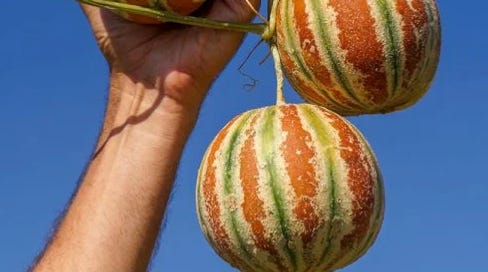




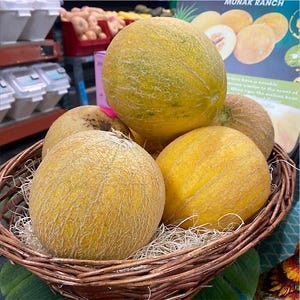





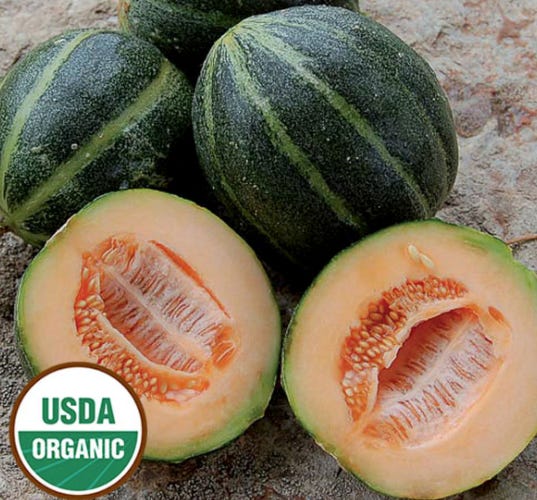









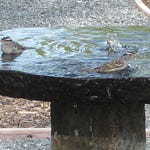



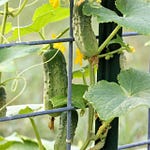


Share this post